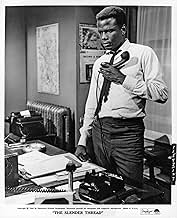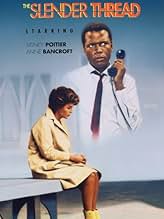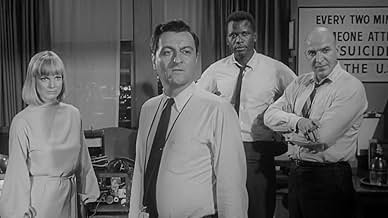IMDb RATING
7.0/10
2.6K
YOUR RATING
College volunteer Alan Newell is working alone at the crisis center one evening when he receives a telephone call from suicidal caller Inga Dyson, who has swallowed a bottle of sleeping pill... Read allCollege volunteer Alan Newell is working alone at the crisis center one evening when he receives a telephone call from suicidal caller Inga Dyson, who has swallowed a bottle of sleeping pills. Can Alan save her?College volunteer Alan Newell is working alone at the crisis center one evening when he receives a telephone call from suicidal caller Inga Dyson, who has swallowed a bottle of sleeping pills. Can Alan save her?
- Director
- Writers
- Stars
- Nominated for 2 Oscars
- 2 wins & 4 nominations total
H.M. Wynant
- Doctor Morris
- (as H.N. Wynant)
Bob Hoy
- Patrolman Steve Peters
- (as Robert Hoy)
- Director
- Writers
- All cast & crew
- Production, box office & more at IMDbPro
Featured reviews
I saw this title coming up on TCM, read the synopsis, and KNEW instantly that this one I had to see. And like I said, I should have known. Poitier is probably one of the top ten dramatic actors of ALL TIME! I'm not sure I've ever seen a bad film that he was in. This little gem, was tremendous. I don't comment on many film's but when I see one I haven't seen before, and it's as good as this one, I can't restrain myself. Watch it when/if you can, and you won't be disappointed! There are many subplots and twists to this film, and it has many fine performances, including Telly Savalas, and Ann Bancroft. There are small parts, for a young Dabney Coleman, and one of Ed Asner's early ones as well. I am a classic movie buff, with over 800 titles in my library, and I simply love it when I come across a new one that I hadn't seen/heard of before. Like I said, Watch this one when/if you can.
I believe that this was Sydney Pollack's directorial debut. If so, then he certainly gave an interesting insight into his future work. Seattle college student Alan Newell (Sidney Poitier) is working at a crisis hotline center when he gets a call from housewife Inge Dyson (Anne Bancroft), who is reaching the breaking point. Because they can't see each other, it gives the movie a real sense of tension, as implied by the title - even if it drags a little bit at times.
A previous reviewer said that Poitier plays his usual role: a morally superior black man in a white-dominated society. That's partly true, but here, he has a job that anyone could have, and his race doesn't really matter (although as the reviewer noted, they could have been subtly talking about race). As for Anne Bancroft, her death six months ago brings her filmography to mind. This may have not been her most famous role, but I would recommend it.
A previous reviewer said that Poitier plays his usual role: a morally superior black man in a white-dominated society. That's partly true, but here, he has a job that anyone could have, and his race doesn't really matter (although as the reviewer noted, they could have been subtly talking about race). As for Anne Bancroft, her death six months ago brings her filmography to mind. This may have not been her most famous role, but I would recommend it.
The late Sydney Pollack tried his hand at several different genres and succeeded in most; since he never demonstrated an individualistic style (for many he was the antithesis of an auteur!), he could adapt himself to virtually anything (and Pollack often set his sights on grand themes) – though the end result would always be somewhat artificial (if undeniably slick) because of the director’s impersonal approach!
Anyway, for his debut film, he settled on an intimate melodrama – shot on location in glorious black-and-white (incidentally, all his subsequent work would be in color). The plot is simple: Sidney Poitier is a student who works nights at a Seattle Crisis Clinic; on one occasion, a call comes in where a wealthy socialite at the end of her tether (Anne Bancroft) declares she has deliberately overdosed on barbiturates! She phoned not so much because she wanted help but rather so that someone will know of her outcome; Poitier, however, determines to keep her on the line – while he sets in motion a complex operation in order to trace Bancroft’s whereabouts and save her life.
For about the first third of the film, Bancroft barely appears: we only hear her world-weary voice booming across the room at the clinic, Poitier having switched the call to the loudspeaker; eventually, she starts to let her hair down and, in intermittent flashbacks, we see her movements during the last few days (which boils down to her alienation from familial cords due to a past mistake which has come back to haunt her). While this was certainly a way to do it, I’m baffled as to why we never cut to where Bancroft is now until the last act: consequently, we have to contend with a fair bit of padding during the ‘re-enactments’ (which could have easily been covered via dialogue delivered by the heroine)! That said, I guess it was a conscious decision on Pollack’s part to ‘open up’ the drama (not merely to include other characters – most prominently, Steven Hill as the woman’s husband – but also to utilize a number of exteriors, where he was able to exercise a keen eye for realistic detail).
Still, the film compels attention despite an essentially contrived central situation: for instance, at this point, it’s best not to go into how Bancroft manages to remain lucid for so long or, even more importantly, why she just doesn’t hang up on Poitier; and what about the plausibility of the latter’s temper-tantrums (to the exasperation of clinic psychiatrist Telly Savalas!) to coerce the woman into reacting, thus hanging on to life in spite of herself? But that’s Hollywood for you…and, in a talky film such as this, the emphasis is on the writing (by Stirling Silliphant) and the acting (Bancroft is typically excellent and Poitier’s contribution, amounting to a variation on his PRESSURE POINT [1962] role, just as good if slightly overstated in the long run). Even so, as a counter-balance to the ongoing histrionics, reasonable suspense – aided by up-to-date methods of detection – is generated throughout by the race-against-time to locate Bancroft.
At the end of the day, THE SLENDER THREAD emerges as a quite impressive (and generally still powerful) first outing – recalling the gritty work of many a contemporary film-maker who, like Pollack, had emerged from TV.
Anyway, for his debut film, he settled on an intimate melodrama – shot on location in glorious black-and-white (incidentally, all his subsequent work would be in color). The plot is simple: Sidney Poitier is a student who works nights at a Seattle Crisis Clinic; on one occasion, a call comes in where a wealthy socialite at the end of her tether (Anne Bancroft) declares she has deliberately overdosed on barbiturates! She phoned not so much because she wanted help but rather so that someone will know of her outcome; Poitier, however, determines to keep her on the line – while he sets in motion a complex operation in order to trace Bancroft’s whereabouts and save her life.
For about the first third of the film, Bancroft barely appears: we only hear her world-weary voice booming across the room at the clinic, Poitier having switched the call to the loudspeaker; eventually, she starts to let her hair down and, in intermittent flashbacks, we see her movements during the last few days (which boils down to her alienation from familial cords due to a past mistake which has come back to haunt her). While this was certainly a way to do it, I’m baffled as to why we never cut to where Bancroft is now until the last act: consequently, we have to contend with a fair bit of padding during the ‘re-enactments’ (which could have easily been covered via dialogue delivered by the heroine)! That said, I guess it was a conscious decision on Pollack’s part to ‘open up’ the drama (not merely to include other characters – most prominently, Steven Hill as the woman’s husband – but also to utilize a number of exteriors, where he was able to exercise a keen eye for realistic detail).
Still, the film compels attention despite an essentially contrived central situation: for instance, at this point, it’s best not to go into how Bancroft manages to remain lucid for so long or, even more importantly, why she just doesn’t hang up on Poitier; and what about the plausibility of the latter’s temper-tantrums (to the exasperation of clinic psychiatrist Telly Savalas!) to coerce the woman into reacting, thus hanging on to life in spite of herself? But that’s Hollywood for you…and, in a talky film such as this, the emphasis is on the writing (by Stirling Silliphant) and the acting (Bancroft is typically excellent and Poitier’s contribution, amounting to a variation on his PRESSURE POINT [1962] role, just as good if slightly overstated in the long run). Even so, as a counter-balance to the ongoing histrionics, reasonable suspense – aided by up-to-date methods of detection – is generated throughout by the race-against-time to locate Bancroft.
At the end of the day, THE SLENDER THREAD emerges as a quite impressive (and generally still powerful) first outing – recalling the gritty work of many a contemporary film-maker who, like Pollack, had emerged from TV.
...even if it couldn't be made today, at least the way it was made then.
It was a terrific suspense movie that had the added benefit of showing Poitier in a totally race-neutral role as young psychology student Alan Newell who is volunteering at the local suicide hotline crisis center on a night that he has every reason to believe will be quiet...and then Inga Dyson (Ann Bancroft) calls him. She has just taken a bottle of barbiturates, does not want to be rescued, but does want to talk. So Alan has to keep his cool and keep Inga on the line long enough to be found, and she only has about 90 minutes to live.
What makes this movie totally anachronistic today is that the entire plot centers around a coordinated effort by scores of public servants in Seattle to trace Inga's phone number and save her before the pills do their job. Of course it would take about 10 seconds for the line to be traced today, which would kind of do away with the suspense.
The suspense is that her call COULD be traced, but it requires the huge telephone company building with countless thousands of connecting plugs and wires that had to be narrowed down, plus the police and fire departments and the State Department of Motor Vehicles, in order to locate the caller's number and where she was calling from. It was like a giant public works department that gave employment to pretty much every proactive player we see in the movie.
In the character development department we have a conversation between Alan an Inga in which we see how she got to the point of despair. It is one part of unforgiveness on her husband's part for a deed done before they were ever married, too much time on Inga's hands one day as the husband continues to stay emotionally detached from her as though she is some unclean thing, the fact that she wanted to talk to somebody about how she felt but could find nobody who would, and the final straw involves the death of an injured bird that is regarded callously by those around her while she tries to help.
In addition to Poitier and Bancroft, Steven Hill gives a chilling and highly credible performance as the unforgiving husband who's driven Bancroft to her suicide attempt. He's such a creepy character that he makes us almost want to force him to swallow those pills instead, and that's a sign that he plays the part to perfection.
Highly recommended because the emotions still ring true even if the technology is long gone.
It was a terrific suspense movie that had the added benefit of showing Poitier in a totally race-neutral role as young psychology student Alan Newell who is volunteering at the local suicide hotline crisis center on a night that he has every reason to believe will be quiet...and then Inga Dyson (Ann Bancroft) calls him. She has just taken a bottle of barbiturates, does not want to be rescued, but does want to talk. So Alan has to keep his cool and keep Inga on the line long enough to be found, and she only has about 90 minutes to live.
What makes this movie totally anachronistic today is that the entire plot centers around a coordinated effort by scores of public servants in Seattle to trace Inga's phone number and save her before the pills do their job. Of course it would take about 10 seconds for the line to be traced today, which would kind of do away with the suspense.
The suspense is that her call COULD be traced, but it requires the huge telephone company building with countless thousands of connecting plugs and wires that had to be narrowed down, plus the police and fire departments and the State Department of Motor Vehicles, in order to locate the caller's number and where she was calling from. It was like a giant public works department that gave employment to pretty much every proactive player we see in the movie.
In the character development department we have a conversation between Alan an Inga in which we see how she got to the point of despair. It is one part of unforgiveness on her husband's part for a deed done before they were ever married, too much time on Inga's hands one day as the husband continues to stay emotionally detached from her as though she is some unclean thing, the fact that she wanted to talk to somebody about how she felt but could find nobody who would, and the final straw involves the death of an injured bird that is regarded callously by those around her while she tries to help.
In addition to Poitier and Bancroft, Steven Hill gives a chilling and highly credible performance as the unforgiving husband who's driven Bancroft to her suicide attempt. He's such a creepy character that he makes us almost want to force him to swallow those pills instead, and that's a sign that he plays the part to perfection.
Highly recommended because the emotions still ring true even if the technology is long gone.
Sidney Poitier and Anne Bancroft do not have any scenes together in this movie, which is about his attempts to keep her on the telephone long enough to trace the call, since she's just taken an overdose of pills. It may sound stagnant but it never is - there is some great cinematography and location shooting (in Seattle). A lot of the story is flashbacks, as you find out why Anne has tried to off herself. Her performance is poignant and she never overdoes it; Sidney is perfect, as always.
Tech credits are first rate - scoring by Quincy Jones, costumes by Edith Head, and a Westmore on make-up. I believe this was the first directing job by Sydney Pollack - he did a nice job.
Its okay that the stars never met, they met in real life - Bancroft presented Sidney with his only Oscar, for "Lilies of the Field" two years earlier. And this would make a good double-bill with "'night, Mother", in which Bancroft is on the other end of a suicide attempt.
Tech credits are first rate - scoring by Quincy Jones, costumes by Edith Head, and a Westmore on make-up. I believe this was the first directing job by Sydney Pollack - he did a nice job.
Its okay that the stars never met, they met in real life - Bancroft presented Sidney with his only Oscar, for "Lilies of the Field" two years earlier. And this would make a good double-bill with "'night, Mother", in which Bancroft is on the other end of a suicide attempt.
Did you know
- TriviaThis film shows the tedious process in 1965 of what was required in tracing a telephone call on actual central office equipment that was state of the art such as number 5 cross bar and step-by-step electro/mechanical equipment. It was filmed in central offices of the old Northwest Bell Telephone company which as of 2010 is now Century Link. Modern telephone switching equipment can trace a call in less than a minute or even 30 seconds.
- GoofsAfter Inga attempts suicide by drowning herself in the bay, she arrives at hospital with perfectly styled hair.
- Quotes
Mark Dyson: [to Inga] Do you think that not getting caught in a lie is the same as telling the truth?
- ConnectionsFeatured in The Directors: The Films of Sydney Pollack (2000)
- How long is The Slender Thread?Powered by Alexa
Details
- Release date
- Country of origin
- Language
- Also known as
- Trente minutes de sursis
- Filming locations
- Production company
- See more company credits at IMDbPro
- Runtime
- 1h 38m(98 min)
- Color
- Sound mix
- Aspect ratio
- 1.85 : 1
Contribute to this page
Suggest an edit or add missing content





































